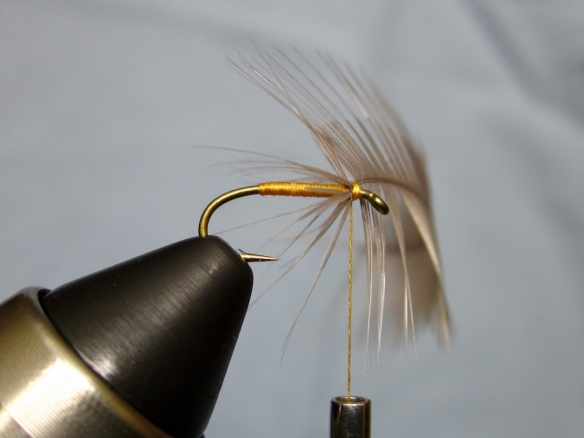February already. Where does the time go? As the unseasonably warm PA winter marches towards Spring, plans have begun for annual pilgrimages to many of the trout rich streams Pennsylvania has become known for. Anglers, myself included, will be keeping fingers crossed that these trips coincide with the yearly hatches that keep trout looking up. The Hendricksons, Quill Gordons, Sulphurs, Cahills, March Browns, and of course, the Drakes. It is time to start stocking fly boxes.
Call it a new years resolution, but the one style of fly that I’d like to fish more of in 2012 is the venerable soft-hackle. Popularized by the late Sylvester Nemes in America, the soft-hackle, spider, or North Country fly has had a long history in angling. This style was perfected by the people of Yorkshire, Cumbria, Lancashire, Staffordshire, and Derbyshire in the UK while normally fishing for sustenance and not sport. It is quite a killing style even today. The definition I most refer to for a soft-hackle comes from Mike Harding, “…a hook with a slim body of touching turns of old-fashioned silk, and headed with a twist or two of feather from a game bird or farmyard hen.”
This particular example I’ve tied is something that I’ll use for Sulphurs later in Spring. I’ve used elements of the common Partridge and Orange and the more obscure Dotterel Dun. This version is quite basic (less is more) but many variations can be made. Underbodies of silver mylar or fluorescent orange thread will show through the gold silk when wet. A fine wire rib or even a herl thorax can increase it’s effectiveness. Fishing soft-hackles is just one more way to stay in touch with the history of fly fishing, which I find important, and I might even land a trout or two.
Hook: TMC 3769 size 14 (any wet fly or nymph hook will work)
Thread: Pearsall’s Gold #6A (I recommend the real stuff)
Hackle: Whiting dyed dun genetic hen cape

Wrap silk back to the mid-point of the hook point and barb. I use a bobbin holder for the smaller silk spools.
Thanks as always for reading.







nemes would wrap the hackle around the thread, then tie it up that way, then rib back over it to reinforce.
i’m lazy. never bother to do that but supposedly its “more realistic.” -shrug-
pearsall’s #8 purple is the prettiest colour i’ve ever seen, also. i tie flies with it strictly because its so sweet to look at.
I love Nemes technique but I, like you, am a little lazy when it comes to tying.
That Pearsalls #8 with starling is nice. Shimmery. I don’t know what its supposed to look like but I fish it.
Oh, btw, where are you getting your snowshoe hares’ feet for Ususals from? Local shop? Online? I’m trying to tie some spinners with hare wings.
Soft hackles are great flies, I spend more time with them than any other type. The silk body is the tradition, but also very effective is a dubbed Hare’s Ear body or wrapped pheasant tail barbs. For both of these, I apply a wire rib. Have used with much success in riffled water here in Michigan, and in mountain streams of Colorado. Cast down and across, let it swing on a tight line. You feel the strike rather than see it. Effective because you cover a lot of water when moving downstream.
hareline? umqua? i dunno. plastic bag. white label. i think that’s hareline.
i should probably undertake that goal. i never use spinners. in my world, i like to think parachutes cover that base.
I fish soft hackle wets with weighted bodies. Deadly. A loose wispy cast lets the fly sink down to the cobble where real insects emanate. The current then lifts them up in a swing that looks the an actual rising insect. Look at underwater video of emerging insects some time. That is the behavior you want to imitate. Unweighted flies just drop a few inches in the water column most of the time. That’s why you will only catch (to use your words) ‘a few fish’. Unweighted flies only work best in modest to heavy hatch situations.
Think about wet fly use 400-500 years ago. The bodies were heaver because of the materials used. The fly got deeper in the water column.
Tight lines and screeching reels,
Cats.